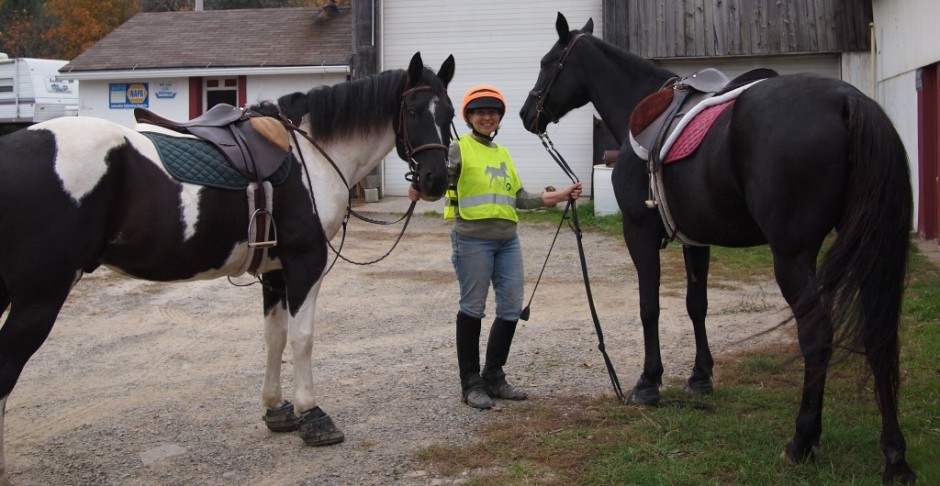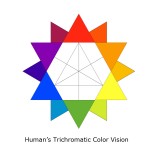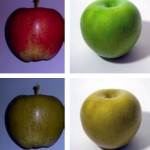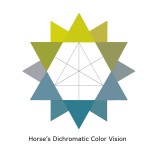A few weeks ago, Karen Sykas and I began ,training CJ to jump. The first step was getting him to walk over a series of ground poles or cavalletti. At first CJ was afraid of the white poles on the ground but after some work he relaxed and walked over them. Karen suggested painting some poles with red or blue strips. That sounded like a good idea and I painted one of the poles with red stripes. I wasn’t surprised when CJ was afraid of the new pole since when I rode him on the road brightly colored vehicles, especially red cars, frighten him. Sure enough, he didn’t like the new pole. I was convinced that CJ could see red but after doing some research on-line I’m not so sure what CJ really sees.
The research data was scant. Behavioral studies were conducted on a very limited sample group: a few horses owned by the researchers. In statistical terms that wouldn’t be a large enough sample size to base an outcome on. Also, since the researchers owned the horses they may have influenced the results. Another problem is that different horse breeds may see different colors.
So what do we know about color vision in horses? The current research tells us that horses have dichromatic vision which basically means they see two-colors. On the other hand, humans have trichromatic vision and see all of the colors of the visual spectrum (unless the person is colorblind). Basically, horses have two types of cones in their eyes; a short wavelength-sensitive cone that allows the horse to see bluish-grey and a middle-long wavelength cone which allows the horse to see yellow. This means that colors like red appear greener to the horse.
One researcher, Dr. Carol Hall, found that her horses could distinguish any color from grey. She also found that horses see better at ground level than at eyelevel. Hall undertook experiments when another researcher concluded that horses can’t tell the difference between yellow and white.
“I had a horse that would ignore white lines on the road but had a real ‘spook’ if she came across yellow ones,” Hall said. “Hence when I read that one study … (which) concluded that they couldn’t tell the difference between yellow and white, I felt strongly that this was not the case.”
It’s not a bad idea to design jumps with the knowledge that horses have limited color vision. Many people paint jumps a different color and shade from the surrounding landscape. Studies have shown that it is less likely for the horse to knock the rail down if the jump is painted with two or more contrasting colors. The poles I’m using for jumps are white which has a high contrast to the green of the surrounding landscape. However, it does seem that CJ jumps the red and white pole with more gusto. So in the spring I’ll paint a few more stripes on those white rails.
Although, there is conflicting information in research studies about what colors horses see, the important thing to remember is that horses see the world very differently than we do. If anyone has had a “color” experience with a horse please leave a comment. It’s always interesting to see what other riders have encountered and how they dealt with problems. In the coming weeks, I plan to write more about equine vision. Happy trails to everyone and stay warm.
Sources:
http://www.us.elsevierhealth.com/media/us/samplechapters/9780702026348/9780702026348.pdf;CA Hall, HJ Cassaday, AM Derrington
Journal of Animal Science (2003) 81, 1715 – 1720; Hall http://www.hindawi.com/journals/ijz/2009/721798/;
http://www.sjsu.edu/people/steven.macramalla/courses/c2/s1/Saslow____understanding_the_percetual_world_of_horses.pdf; http://www.thehorse.com/articles/21019/equine-color-vision-research-seeing-things-differently; http://horsetalk.co.nz/2012/11/21/vision-horses-more-than-meets-the-eye/;http://en.wikipedia.org/wiki/Equine_vision;http://www.equineresearch.org/support-files/hanggi-thinkinghorse.pdf; http://www.equineresearch.org/support-files/hanggi-colorvision.pdf
Copyright © 2013 Patricia Miran All Rights Reserved



